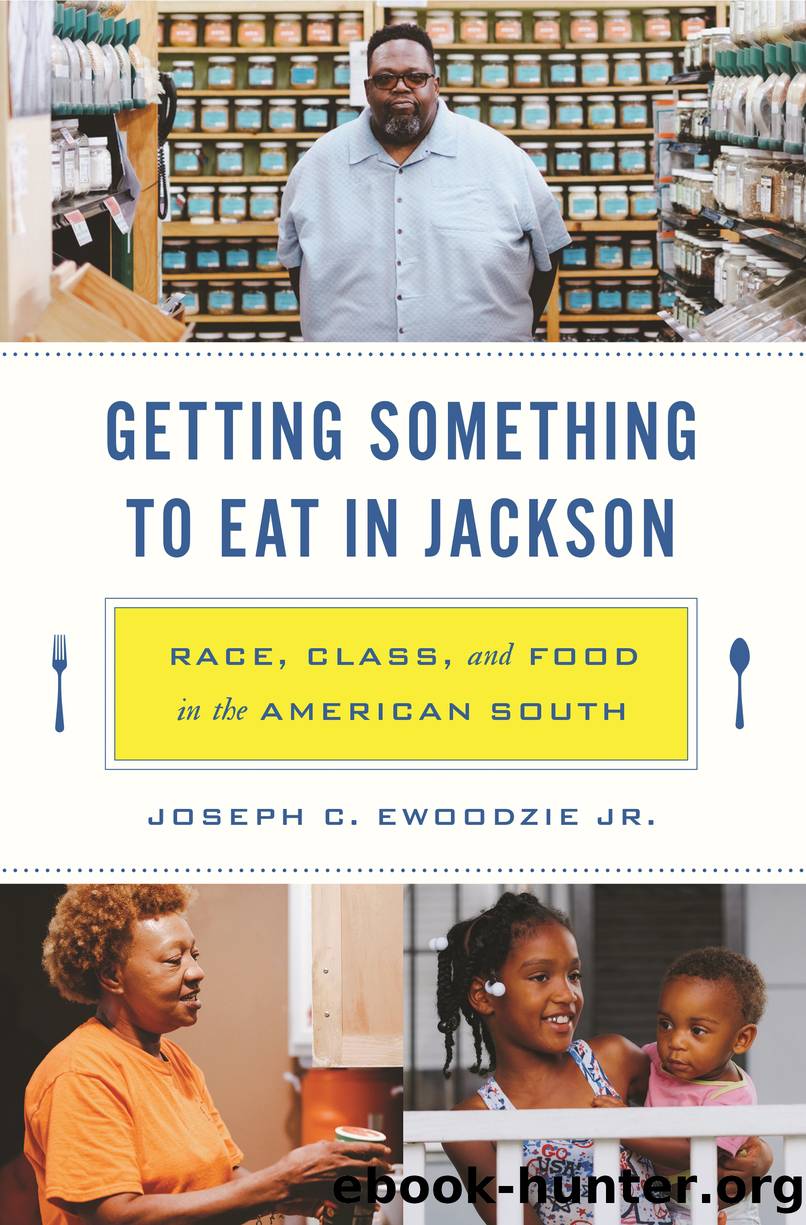Getting Something to Eat in Jackson by Joseph C. Ewoodzie Jr

Author:Joseph C. Ewoodzie Jr.
Language: eng
Format: epub
Publisher: Princeton University Press
Published: 2021-07-27T00:00:00+00:00
Food Consciousness
How do members of the Black lower-middle class make decisions about what they eat? Their class privileges offer more relative stability, economic and otherwise, and so their food choices are shaped by a broader range of influences. Their navigations of socioeconomic structures do not deplete their time, energy, and resources as they do for those in poverty. Specifically, because they have stable housing and employment, they do not have to spend as much time navigating the housing market or applying for jobs. With more time and energy, they entertain different factors in their food choices. To follow how I explained Zenani and Ms. Beaâs food choices, how the past, present, and future elements of decision-making come to matter, I argue here that their food choices include more than just their past or present.10 Their food choices include their projections of their future desires. So, how do they manage the various potential influences? The answer to that question lies in looking into peopleâs food consciousness, an important but often ignored part of food discussions, especially food choices.
Sociologists who try to explain peopleâs actions have wondered about the importance of consciousness, especially in how different actions become routines and habits. Here, I treat food choices as actions and place them in this same conversation. I am interested in understanding how various considerations (e.g., health and environmental) become part of someoneâs food decision-making, including how new considerations become included in decisions and eventually become taken for granted.11 For one theorist, Anthony Giddens, consciousness exists on multiple levels: on the level of practical consciousnessâwhere actors bring to their taken-for-granted actions and unnoticeable know-howâand discursive consciousnessâwhere actors actively and reflexively bring and incorporate new knowledge into their acts.12
My exploration of food consciousness follows this line of thinking: it is as much at the level of practical consciousness as it is at the level of discursive consciousness. It is as much about day-to-day food decisions as it is about decisions to take part in diets, as much about the daily choices of Ms. Monique and her family as it is about deciding to follow the keto diet, for example. What is more, food consciousness does not live in oneâs head but in a social context, often racialized and classed. It is not just rationally weighing which foods are good for oneâs health or the environment. It is embroiled in the messiness of everyday life.
With these ideas in mind, I make the following case for how to understand how Black folks like Ms. Monique and Charles make decisions about what they eat. I show that, because they have more time and resources than those in poverty, their decisions are not just based on the present circumstances. Again, their present circumstance is significant, but not dominant. For instance, they have the resources to explore and develop different tastes because of their class background. These different tastes can be pleasurable lifestyle preferences, like developing new tastes in Japanese cuisine. In addition, their food choices might also be shaped by their desired future possibilities, such as the resources to become vegan.
Download
This site does not store any files on its server. We only index and link to content provided by other sites. Please contact the content providers to delete copyright contents if any and email us, we'll remove relevant links or contents immediately.
Craft Beer for the Homebrewer by Michael Agnew(17933)
Marijuana Grower's Handbook by Ed Rosenthal(3512)
Barkskins by Annie Proulx(3191)
Project Animal Farm: An Accidental Journey into the Secret World of Farming and the Truth About Our Food by Sonia Faruqi(3018)
Red Famine: Stalin's War on Ukraine by Anne Applebaum(2816)
The Plant Messiah by Carlos Magdalena(2745)
0041152001443424520 .pdf by Unknown(2593)
Organic Mushroom Farming and Mycoremediation by Tradd Cotter(2566)
In the Woods by Tana French(2411)
Beer is proof God loves us by Charles W. Bamforth(2250)
7-14 Days by Noah Waters(2247)
The Art of Making Gelato by Morgan Morano(2160)
Reservoir 13 by Jon McGregor(2144)
Meathooked by Marta Zaraska(2144)
Birds, Beasts and Relatives by Gerald Durrell(2135)
Borders by unknow(2117)
The 7 Habits of Highly Effective People: Powerful Lessons in Personal Change (25th Anniversary Edition) by Covey Stephen R(2080)
Between Two Fires by Christopher Buehlman(2044)
The Lean Farm Guide to Growing Vegetables: More In-Depth Lean Techniques for Efficient Organic Production by Ben Hartman(2010)
